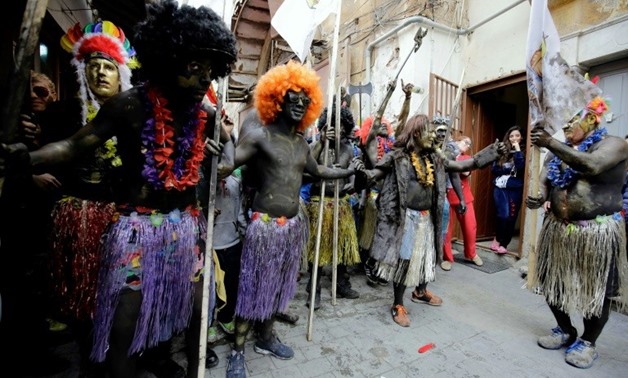
Lebanese take part in the Zambo carnival held in the northern city of Tripoli to mark the last period of excess on the eve of Orthodox Christian period of Lent
Residents of the Lebanese city of Tripoli donned bright, curly wigs and dark body paint Sunday for Zambo, a festival on the eve of the start of the Orthodox Christian period of Lent.
The origins of the annual celebration remain unclear and it only seems to take place in a seaside suburb of Tripoli, a Muslim-majority city with an Orthodox minority.
But that has never dampened revelers, dozens of whom hopped and danced their way through Tripoli's streets, glittery hats on their heads and sceptres in hand, a day before the beginning of the fast for eastern-rite Christians.
"Zambo, zambo, zambo!" they chanted.
"This festival is more than 100 years old, passed on and enjoyed from generation to generation," said Beshara Hassan, 48. "People come from all over to take part, from all sects."
Lebanon, a country of over four million, is home to 18 religious communities.
Muslims and Christians often take part in each other's festive holidays -- but no one is quite sure where Zambo came from.
Ahmad Sawalhi, 25, is a native of the Mina suburb of the northern city of Tripoli where Zambo is fervently celebrated.
"Zambo is a Greek custom, but it only happens here in Tripoli before our Christian brothers begin Lent," said Sawalhi, who is Muslim but takes part every year.
Ibrahim Touma, another Zambo enthusiast, told AFP that the tradition dates back at least to 1932, but perhaps even earlier.
"There's no doubt that the real origin of the festival is unknown," he said.
One theory is that it originated with Lebanese visiting from Brazil and Argentina, Touma said, while another traces it to Senegalese forces stationed in Lebanon during World War II.
"My grandmother used to tell me that Senegalese units used to put on these evening masquerades to calm down people in Mina, who were scared of the Vichy (French) bombing," said Touma.
After a two-hour parade through Tripoli, the crowd reached the shores of the Mediterranean and ran into the sea, washing off their paint to cleanse themselves before Lent begins.


Comments
Leave a Comment